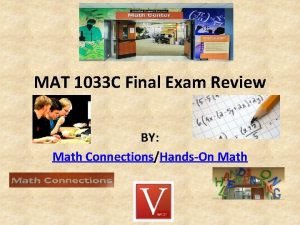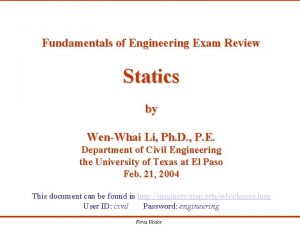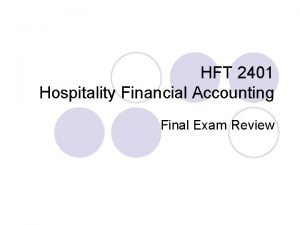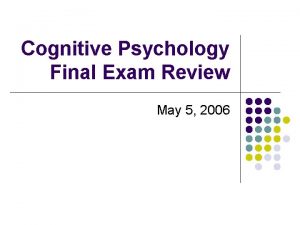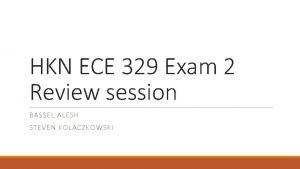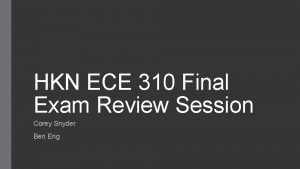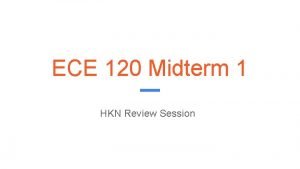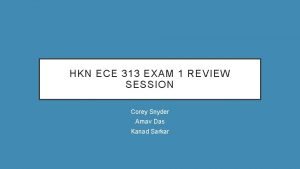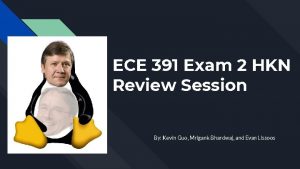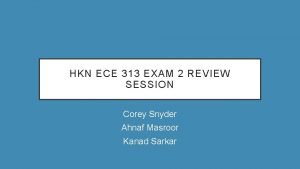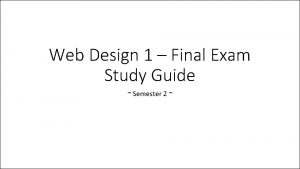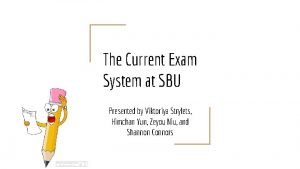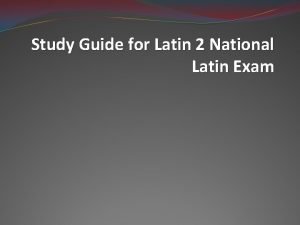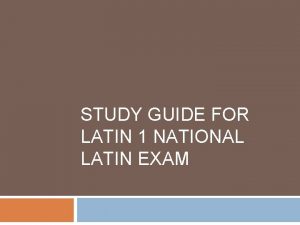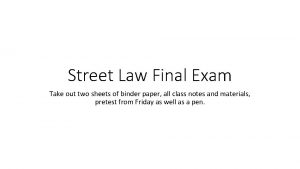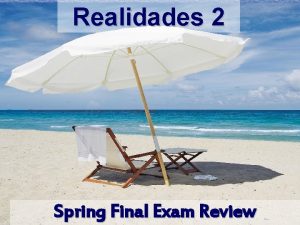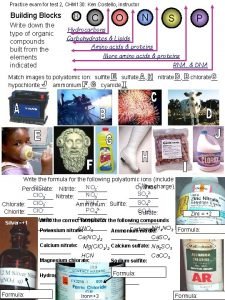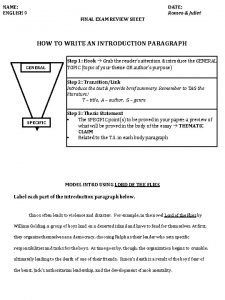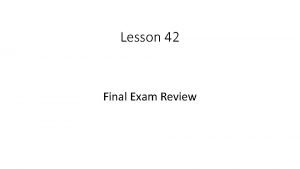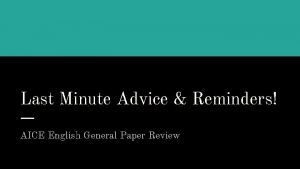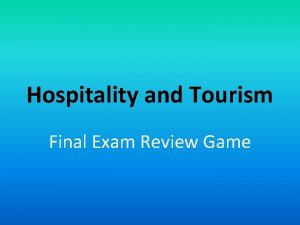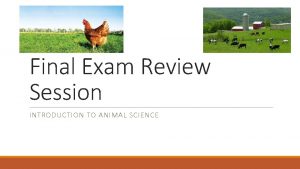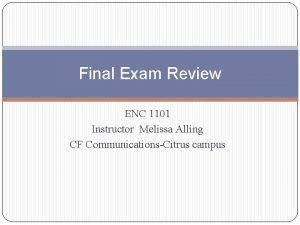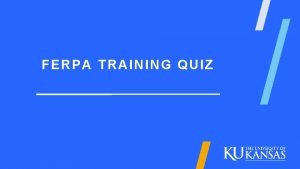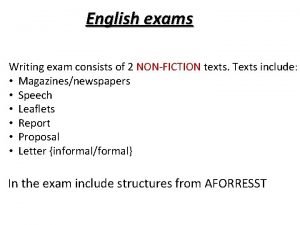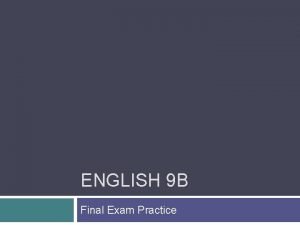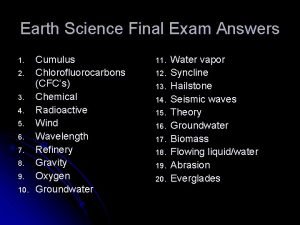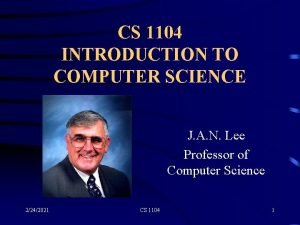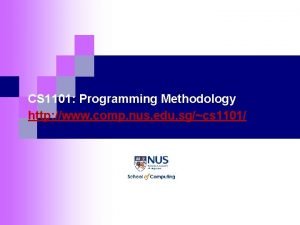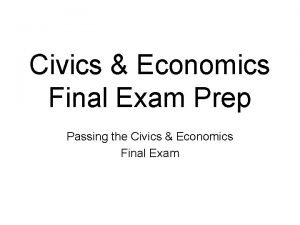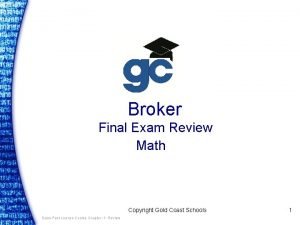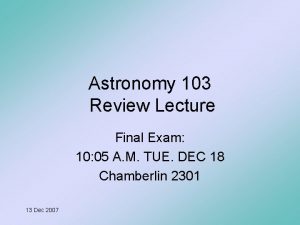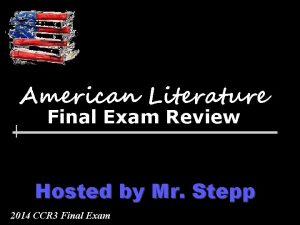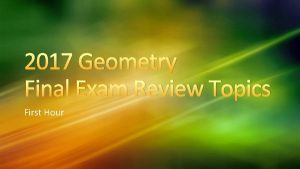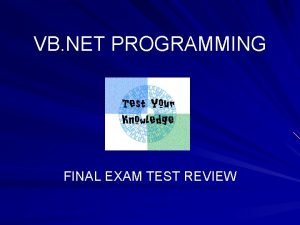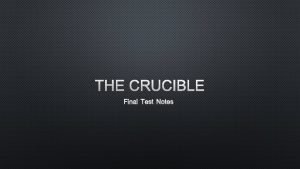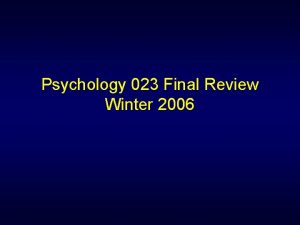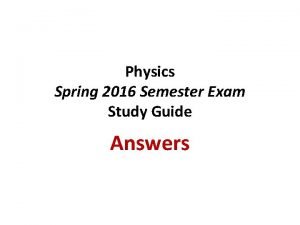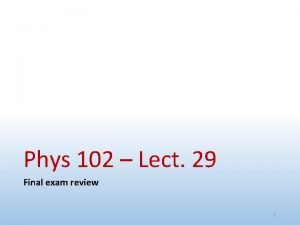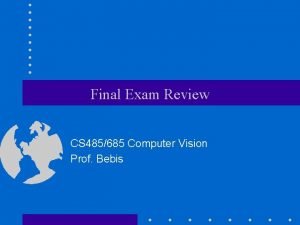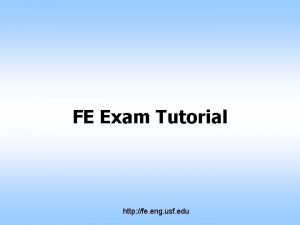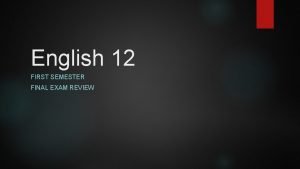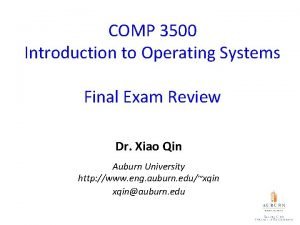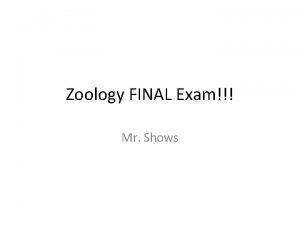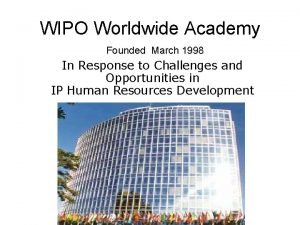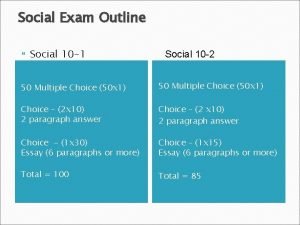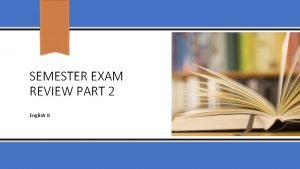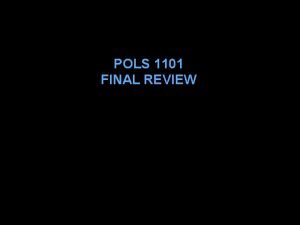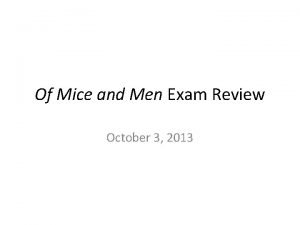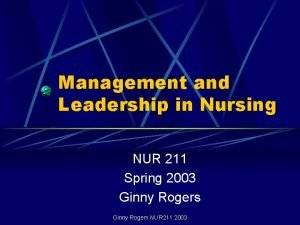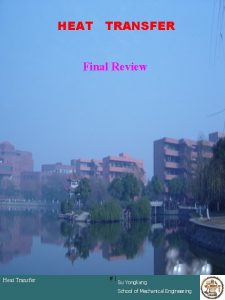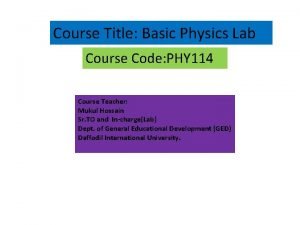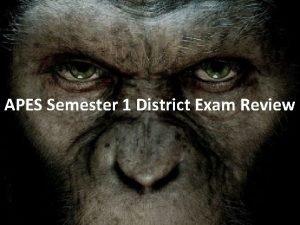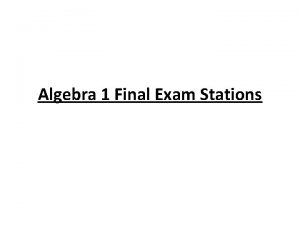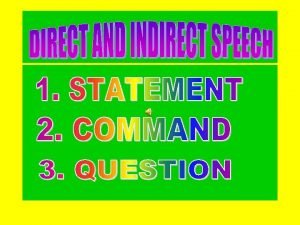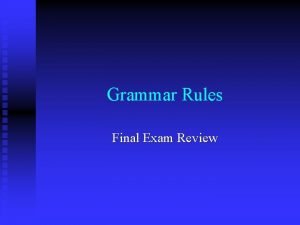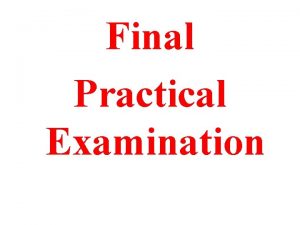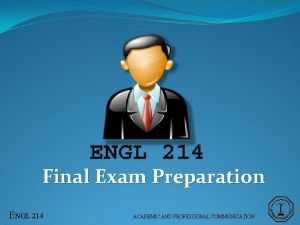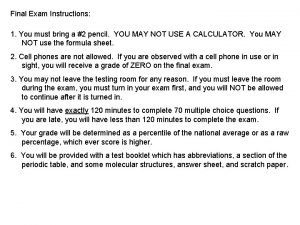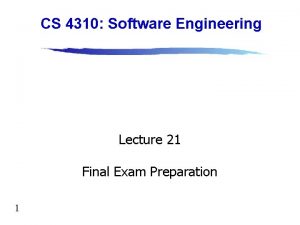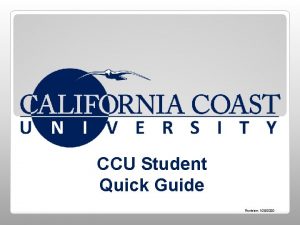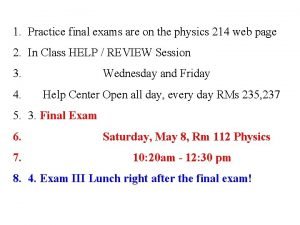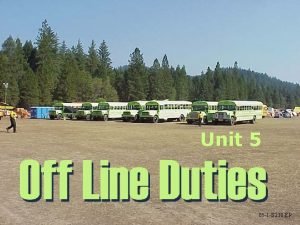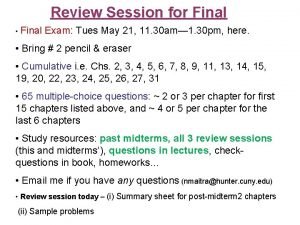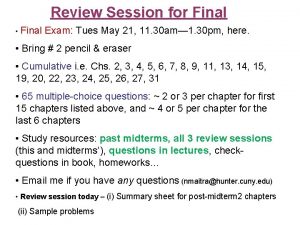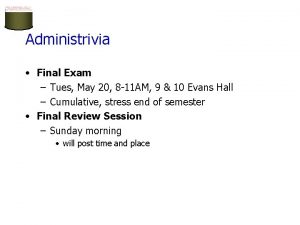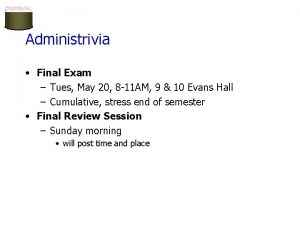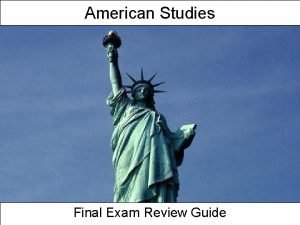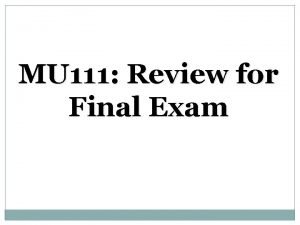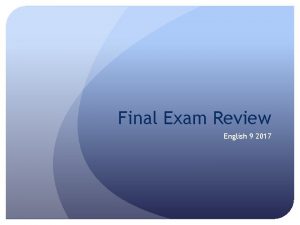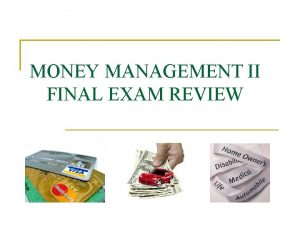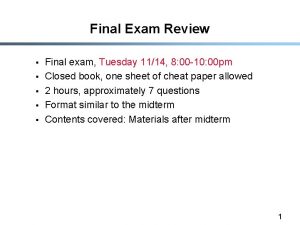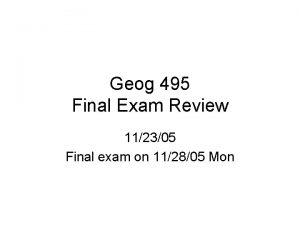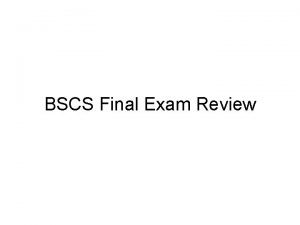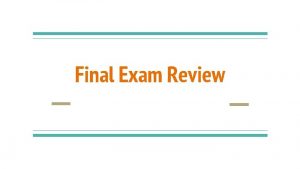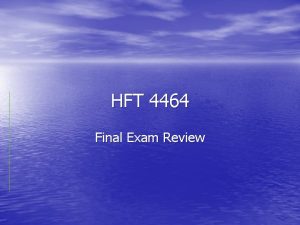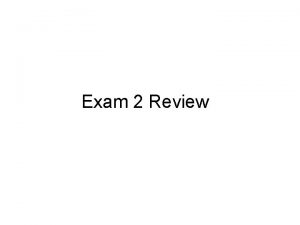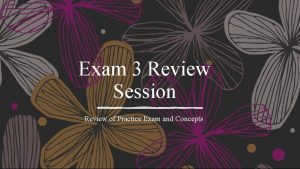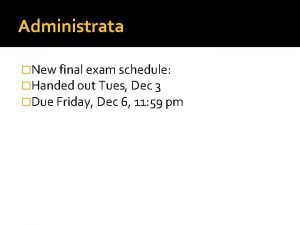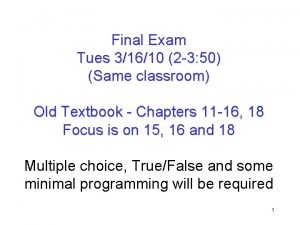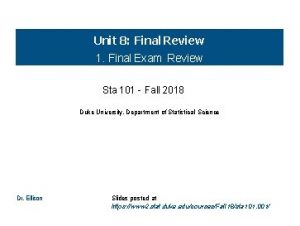Review Session for Final Final Exam Tues May































































































- Slides: 95

Review Session for Final • Final Exam: Tues May 21, 11. 30 am— 1. 30 pm, here. • Bring # 2 pencil & eraser • Cumulative i. e. Chs. 2, 3, 4, 5, 6, 7, 8, 9, 11, 13, 14, 15, 19, 20, 22, 23, 24, 25, 26, 27, 31 • 65 multiple-choice questions: ~ 2 or 3 per chapter for first 15 chapters listed above, and ~ 4 or 5 per chapter for the last 6 chapters • Study resources: past midterms, all 3 review sessions (this and midterms’), questions in lectures, checkquestions in book. • Email me if you have any questions (nmaitra@hunter. cuny. edu) • Review session today – (i) Summary sheet for post-midterm 2 chapters (ii) Sample problems

Summary sheet for Chs. 23 – 31 Recall: Ch 23: Electric Circuits: flow of charge = current, potential difference, voltage sources, resistance, Ohm’s law: current = voltage/resistance, DC and AC, speed and source of electrons in circuit, electric power = current x voltage, series and parallel circuits, overloading Ch 24: Magnetism, magnetic forces, poles, magnetic fields, magnetic domains, magnetic field produced by electric current, electromagnet, magnetic force -- perpendicular to charge’s velocity and to magnetic field, magnetic force on current-carrying wires, electric meters, electric motors, earth’s magnetic field and cosmic rays Ch 25: Electromagnetic induction, voltage induced by time-varying magnetic field, Faraday’s law, generators, AC, transformers, transformer-equation, generality of field induction: a changing magnetic field induces a changing electric field and vice-versa Ch 26: Properties of Light, electromagnetic waves, speed of EM waves = c = fl, EM spectrum, transparent materials, opaque materials, shadows, eclipses, the eye Ch 27: Color, selective reflection, selective transmission, radiation curve of the sun, additive primary colors, complementary colors, mixing colored lights, mixing colored pigments, color subtraction, why sky is blue and sunsets red, why clouds are white, why water is green-blue Ch 31: Light Quanta, intro to quantum mechanics, historic debate on is light a wave or particle, Planck’s constant, quantization, E=hf for photon, light brightness depends on N, photoelectric effect, Young’s double-slit expt (from Ch 29), wave-particle duality of light as well as of material particles, uncertainty principle Dx. Dp >h/2 p

If you’re in a car that gets hit from behind, you can get whiplash (neck injury) if your head is not against a headrest. This is best explained via: A) your whole body undergoes a sudden acceleration. B) there is an action-reaction pair of forces between your neck and head. C) inertia -- the back of your seat pushes your back forward but your head tends to stay where it was. D) inertia – you resist the motion of the car. E) none of these

What keeps asteroids moving through (mostly empty) space, as they have been doing for billions of years? A) B) C) D) Inertia Gravitational forces Electrical forces Action-reaction forces

A truck is moving at constant velocity. Inside the storage compartment, a rock is dropped from the midpoint of the ceiling and strikes the floor below. The rock hits the floor A) Behind the midpoint of the ceiling B) Ahead of the midpoint of the ceiling C) Exactly below the midpoint of the ceiling D) Need more information to solve this E) None of the above

If a car speeds up from rest to 100 km/h in 20 seconds, its acceleration is A) 100 km/(h. s) B) 2000 km/(h. s) C) 10 km/(h. s) D) 5 km/(h. s) E) None of the above

A rock weighs 30 N on Earth. How much would it weigh on the moon? Note g on the moon is one-sixth that on earth. A) 180 N B) 30 N C) 5 N D) 0 N E) None of the above

An object is thrown down from the top of a cliff at a speed of 10 m/s. Neglecting air-resistance, it’s speed a second later is about A) 20 m/s B) 15 m/s C) 10 m/s D) 0 m/s E) None of the above * take g = 10 m/s 2 unless otherwise stated

If you drop an object, it will accelerate downward at a rate of 9. 8 meters per second. If you instead throw it upwards, its acceleration (in the absence of air resistance) will be A) 9. 8 meters per second. B) greater than 9. 8 meters per second. C) less than 9. 8 meters per second.

If an object falling freely were equipped with an odometer to measure the distance it travels, then the amount of distance it travels each succeeding second would be A) constant B) less and less each second C) greater than the second before D) doubled

A man pulls a sled with a force of 100 N on ice, accelerating it at 4 meters per second. What is the mass of the sled? A)100 kg B) 50 kg C) 40 kg D) 25 kg E) 20 kg

If no external forces are acting on a moving object it will A) move slower and slower until it finally stops. B) continue moving at the same velocity. C) continue moving at the same speed.

Disregarding air drag, how fast must you toss a ball straight up in order for it take 2 seconds to return to the point at which you tossed it? A) 5 m/s B) 7. 5 m/s C) 10 m/s D) 15 m/s E) 20 m/s

In which case would you have the largest mass of gold? If your chunk of gold weighed 1 N on the A) moon B) earth C) planet Jupiter D) same in all cases

A 100 N object is falling through the atmosphere. If, at a certain instant, the air resistance equals 50 N, the object’s acceleration in meters per second, at that instant is A) 10 B) 5 C) 0 D) None of the above

A little girl and her larger and stronger mother attempt a tug-of-war. Who exerts the greater force on the rope? A) The little girl B) The large and strong mother C) Both exert the same force

In order to catch a ball, a baseball player extends the hand forward before impact with the ball, and then lets it ride backward in the direction of the ball’s motion. Doing this reduces the force of impact on the player’s hand principally because the A) force of impact is reduced B) Time of impact is increased C) Time of impact is decreased D) Impulse is smaller

Two billiard balls of the same mass m roll towards each other, one with speed v and the other with twice that speed, 2 v. After the collision, what is their combined momentum? A) 0 B) mv C) 2 mv D) mv/2 E) None of the above

A man pushes a crate of oranges 3 m across the floor with a force of 12 N. How much work is done by the man? A) 12 J B) 15 J C) 36 J D) 108 J E) None of the above

Which requires the greatest amount of work: A) accelerating a car from 10 km/h to 15 km/h B) decelerating a car from 10 km/h to a stop C) Both require the same

If an object has kinetic energy, then it must also have A) Impulse B) Momentum C) Acceleration D) Potential energy E) None of these F) All of these

The chef at the infamous Fattening Tower of Pizza tosses a spinning disk of uncooked pizza dough into the air. The disk's diameter increases during the flight, while its rotational speed A) decreases. B) increases. C) remains constant.

When you turn a bolt using a wrench whose handle is three times as long, you’re multiplying the torque by A) 3 B) 1/3 C) 6 D) 9 E) 1/9

If the Earth's mass decreased to one-half its original mass with no change in radius, then your weight would A) decrease to one quarter your original weight. B) stay the same. C) decrease to one half your original weight. D) none of these

Two planets attract each other with a 400 N gravitational force. If the planets are moved so that the distance between them is twice as far, the force will be A) 400 N B) 200 N C) 100 N D) 1600 N E) None of these

During an eclipse of the sun the high ocean tides on Earth are A) Extra high B) Extra low C) Not particularly different

The best time for digging clams (when the low tide is extra low) is during the time of the A) quarter moon. B) new or full moon. C) half moon. D) none of these times in particular

The smallest particle of those listed below is A) A molecule B) An atom C) A proton D) A neutron E) A quark

If two protons are added to an oxygen nucleus, the result is A) Heavy oxygen B) Fluorine C) Neon D) Sodium E) nitrogen

A dam is thicker at the bottom than at the top partly because A) surface tension exists only on the surface of liquids. B) water pressure is greater with increasing depth. C) water is denser at deeper levels. D) it looks better. E) none of these

The pressure at the bottom of a jug filled with water does NOT depend on A) The acceleration due to gravity B) Water density C) The height of the liquid D) Surface area of the water E) None of these

A hydraulic press multiplies a force by 100. This multiplication is done at the expense of A) energy, which is divided by 100 B) The distance through which the force acts C) The time through which the force acts, which is multiplied by 100 D) The mechanism providing the force E) None of these

A block of styrofoam floats on water while a same size block of lead lies submerged in the water. The buoyant force is greatest on the A) lead. B) styrofoam. C) is the same for both

Blood pressure is usually greatest in your A) ears B) feet C) same in each

As a high-altitude balloon sinks lower and lower into the atmosphere, it undergoes a decrease in A) mass. B) density. C) volume. D) weight. E) none of these

Suspend a pair of Ping-Pong balls from two strings so there is a small space between them. If you blow air between the balls, they will swing A) toward each other. B) apart from each other. C) away from the air stream, but not necessarily toward or apart from each other

When a common fluorescent lamp is on, the mercury vapor inside is actually in a A) solid state. B) plasma state. C) liquid state. D) gaseous state. E) none of these

When you touch a cold piece of ice with your finger, energy flows A) From your finger to the ice B) From the ice to your finger C) actually, both ways

We learnt that water has a particularly high specific heat. What does this imply? A) Water molecules absorb large amounts of energy in the form of internal vibrations and rotations. B) Water molecules absorb very little energy in the form of internal vibrations and rotations. C) Water is the optimal substance for heating other substances. D) Water specifically absorbs heat much more than absorbing sound or other forms of energy. T

The fact that desert sand is very hot in the day and very cold at night is evidence for A) A low specific heat B) A high specific heat C) No specific heat

Between 0 degrees Celsius and 8 degrees Celsius a red-dyed-water-in-glass thermometer would A) Be especially suitable B) Always wrong C) Give ambiguous readings D) Explode E) implode

If the period of a vibrating object is 5 seconds, how many oscillations does it undergo in 1 minute, and what is its frequency? A) 0. 2 oscillations in 1 min, and frequency is 0. 2 Hz B) 6 oscillations in 1 min, and frequency is 12 Hz C) 12 oscillations in 1 min, and frequency is 12 Hz D) 12 oscillations in 1 min, and frequency is 0. 2 Hz E) None of the above is correct

A leaf floating on the water oscillates up and down two complete cycles each second. If the wave travels an average distance of 6 m in one second, its wavelength is A) 0. 5 m B) 1 m C) 2 m D) 3 m E) 6 m

Compressions and rarefactions are characteristic of A) interference B) resonances C) transverse waves D) longitudinal waves E) all types of waves

Why does a foghorn have such a low pitch? A) Because low pitches travel faster than high pitches B) Because low pitches do not dissipate as quickly as high pitches C) Because high frequencies carry farther in air D) Because high frequencies travel faster E) None of the above

If the beat frequency increases as one tightens a violin string played alongside a tuning fork, what should one do to the string in order to tune it to the tuning fork? A) Loosen it B) Tighten it more C) Do nothing D) Need more information

A mosquito zips by you at top speed. What changes in the buzzing sound that you hear as it approaches you, compared to if it wasn’t moving by? A) the sound wave’s speed is increased B) the perceived wavelength is increased C) the perceived frequency is increased D) both the wavelength and frequency are increased

Interference is a property of A) Water waves B) Sound waves C) Light waves D) Waves on a string E) All of the above

Sound refraction depends on the fact that the speed of sound is A) variable B) inversely proportional to wavelength C) proportional to frequency D) constant E) none of the above is correct

To say that electric charge is conserved is to say that electric charge A) will interact with neighboring electric charges. B) is sometimes positive. C) may occur in an infinite variety of quantities. D) is a whole-number multiple of the charge of one electron. E) can be neither created nor destroyed.

The electric field inside an uncharged metal ball is zero. If the ball is negatively charged, the electric field inside the ball is then A) less than zero B) zero C) greater than zero

When the distance between two protons is doubled, the electrical repulsion force between the charges A) Doubles B) quadruples C) halves D) is quartered E) stays the same

The electric field around an isolated electron has a certain strength 1 cm from the electron. The electric field strength 2 cm from the electron is A) Half as much B) The same C) Twice as much D) Four times as much E) None of the above is correct

To say that an object is electrically polarized is to say A) It is electrically charged B) Its charges have been rearranged C) Its internal electric field is zero D) It is only partially conducting E) It is to some degree magnetic

Cool a copper wire and the electrical resistance between its ends A) increases B) decreases C) is unchanged

A 20 -ohm toaster is connected across a 120 -V power supply. What is the current drawn? A) 20 A B) 120 A C) 6 A D) 240 A E) none of these

When a 60 -W light bulb is connected to a 240 -V source, the current in the light bulb is A) 4 A B) 0. 25 A C) 6 A D) 1440 A E) none of these

If a current is flowing in a wire, which of the following must be true? A) The wire must have a high resistance B) There must be a net charge on the wire C) There must be a potential difference across the ends of the wire D) None of the above

When you turn on a light switch, which of the following is true? A) Light is generated almost instantaneously from electrons travelling extremely fast, released from the switch and going through the lamp filament. B) Light is generated from electrons travelling extremely fast from the power plant through to the outlet, then on to the lamp. C) The electrons already present in the lamp filament generate the light, sensing the electric field signal almost instantaneously. D) The electrons already present in the lamp filament generate the light, leaving the entire circuit positively charged.

As more lamps are put into a series circuit, the overall current in the power source A) increases. B) stays the same. C) decreases.

As more lamps are put into a parallel circuit, the overall current in the power source A) increases. B) stays the same. C) decreases.

When we say that an appliance “uses up electricity” we really mean that A) B) C) D) current disappears electric charges are dissipated the main power supply voltage is lowered electrons are taken out of the circuit and put somewhere else E) electron kinetic energy is changed into heat

Consider two lamps almost identical but one with a thicker filament than the other. Which has the higher resistance? A) thicker filament B) thinner filament C) both same D) it depends on the current

Consider again two lamps almost identical but one with a thicker filament than the other. If connected in parallel, which would draw the greater current? A) thicker filament B) thinner filament C) both same D) it depends on the current

When a 40 -W light bulb is connected to a 120 -V source, the current in the light bulb is A) 0. 33 A B) 3 A C) 4 A D) 8 A E) none of these

There are electrons in the filament of the ac lamp in your bedroom. When you turn on the lamp and it glows, the glowing comes from A) the same electrons B) different electrons – coming from the power company C) different electrons – coming from the electrical outlet D) the positive charges that flow in your filament.

As more lamps are put into a parallel circuit, the overall current in the power source A) increases. B) stays the same. C) decreases.

Modern automobile headlights are connected in A) parallel B) perpendicular C) series D) resonance E) None of these

If a steady magnetic field exerts a force on a moving charge, that force is directed A) in the direction of the motion. B) opposite the motion. C) at right angles to the direction of the motion. D) nowhere - there is no force.

The intensity of cosmic rays bombarding the Earth's surface is largest at the A) mid-latitudes. B) equator. C) poles.

The source of all magnetism is A) Tiny pieces of iron B) Tiny domains of aligned atoms C) Ferromagnetic materials D) Moving electric charge E) None of these

When there is a change in the magnetic field in a closed loop of wire A) A voltage is induced in the wire B) A current is created in the loop of wire C) Electromagnetic induction occurs D) All of these E) None of these

Moving a coil of wire into a magnetic field induces a voltage through the coil. If a second coil, that has half as many turns, is pushed in to the field, A) twice as much voltage is induced B) the same voltage is induced C) half as much voltage is induced D) a quarter as much voltage is induced E) none of these

Disconnect a small-voltage battery from a coil of many loops of wire and a large voltage is produced by A) the resistance of the battery to a change in polarity. B) the electric field between the battery terminals. C) the sudden collapse in the magnetic field. D) latent energy in the battery. E) electrons already in the wire.

The voltage across the input terminals of a transformer is 220 V. The primary has 20 loops and the secondary has 40 loops. The voltage the transformer puts out is A) 220 V B) 110 V C) 440 V D) 4400 V E) 8800 V

Power is transmitted at high voltages because the corresponding current in the wires is A) High to deliver appreciable power to distant places B) Low so that overheating of wires is minimized C) It enables power to increase as the current flows D) None of the above

The source of all electromagnetic waves is A) Heat B) Vibrating atoms C) Vibrating electric charges D) Crystalline fluctuations E) Electric fields F) None of these

Things seen by moonlight are not usually colored because moonlight A) doesn’t have very many colors in it B) Is too dim to activate the retina’s cones C) Photons don’t have enough energy to activate the retina’s cones D) All of these E) None of these

When visible light is incident upon clear glass, atoms in the glass A) are forced into vibration B) resonate C) convert the light energy into internal energy D) All of the above

A partial solar eclipse occurs for people in the sun’s A) umbra B) penumbra C) none of these

When blue light is incident on water, atoms in the water A) resonate B) are forced into vibration C) convert the light energy into internal energy

Different colors of light correspond to different light A) velocities. B) intensities. C) amplitudes. D) frequencies. E) none of these

The whiteness of clouds is evidence in the clouds for a variety of A) “seeds” upon which condensation of cloud material forms B) water prisms C) light intensities D) molecules E) particle sizes

The fact that you can get sunburned while submerged in water is evidence that water A) absorbs ultraviolet light B) transmits ultraviolet light C) transmits infrared light D) absorbs infrared light

Complementary colors are two colors that A) are right for each other B) are additive primary colors C) look good together D) produce white light when added together E) are subtractive primary colors

If sunlight were blue instead of white, the most comfortable color to wear on a cold day would be A) blue. B) violet. C) magenta. D) green. E) yellow.

If the sky on some planet in the solar system was yellow during the day, what color would the sunsets there be? A) Green B) Orange C) Yellow D) Blue E) Red

The worst thing you can do for the health of a greenleafed plant is to illuminate it with only A) red light. B) green light. C) blue light. D) All are equally bad E) none of these

In the photoelectric effect, the brighter the illuminating light on a photosensitive surface, the greater the A) Number of ejected electrons B) Speed of ejected electrons C) Both of these D) None of these

Which has the least energy per photon? A) infrared B) ultraviolet C) blue light D) Red light E) They all have the same energy

Why doesn’t microwave radiation cause damage to our living cells like UV does? A) Because microwave radiation is not as intense as UV B) Because each microwave photon does not enough energy to interact with our molecules but each UV photon does C) Because each UV photon has much less energy than each microwave photon so interacts more readily with our molecules D) None of the above

Light behaves primarily as a wave when it A) Travels from one place to another B) Interacts with matter C) Both of the above D) None of the above

The particle nature of light is best illustrated by A) The photoelectric effect B) The double-slit experiment C) Neither

Heisenberg’s uncertainty principle states that A) The position of an object is always uncertain on the scale of Planck’s constant B) The momentum of an object is always uncertain on the scale of Planck’s constant C) If one measures the position very accurately, then little is known about its momentum D) None of the above is true

According to the uncertainty principle, the more we know about a particle's position, the less we know about its A) kinetic energy. B) speed. C) momentum. D) all of these E) none of these
 Ap gov final review
Ap gov final review World history spring final exam review answers
World history spring final exam review answers Spanish 1 semester 1 final exam answer key
Spanish 1 semester 1 final exam answer key Human body systems final exam
Human body systems final exam Poe practice test - materials answer key
Poe practice test - materials answer key Ied final exam
Ied final exam World history fall semester exam review
World history fall semester exam review Entrepreneurship 1 final exam review
Entrepreneurship 1 final exam review Spanish 2 final exam review answer key
Spanish 2 final exam review answer key Final exam study guide environmental science
Final exam study guide environmental science World history final exam review
World history final exam review Us history semester 2 final exam review
Us history semester 2 final exam review English 4 semester 2 exam
English 4 semester 2 exam Physics 20 final exam practice
Physics 20 final exam practice Physical science final exam review
Physical science final exam review Mat 1033 final exam review
Mat 1033 final exam review Statics final review
Statics final review Zoology final exam review
Zoology final exam review Earth science final exam review
Earth science final exam review Algebra 1 final review packet
Algebra 1 final review packet Accounting final exam review
Accounting final exam review Personal finance final exam review
Personal finance final exam review Spanish 1 final review
Spanish 1 final review Psyc 1504 final exam
Psyc 1504 final exam Ece 329
Ece 329 Hkn review
Hkn review Ece 120 uiuc
Ece 120 uiuc Uiuc ece 313
Uiuc ece 313 Ece329
Ece329 Ece391
Ece391 Hkn review session
Hkn review session World history and geography final exam study guide
World history and geography final exam study guide Web design final exam
Web design final exam Us history final exam semester 1
Us history final exam semester 1 Sbu final exam schedule
Sbu final exam schedule Latin 2 final exam answers
Latin 2 final exam answers National latin exam study guide
National latin exam study guide Street law final exam
Street law final exam What is the answer
What is the answer Realidades 2 final exam
Realidades 2 final exam Chemistry 151 final exam
Chemistry 151 final exam Chm 130 chapter 12 practice problems answer key
Chm 130 chapter 12 practice problems answer key Romeo and juliet exam review
Romeo and juliet exam review 42 final exam
42 final exam Aice general paper final exam
Aice general paper final exam Human resource management question paper
Human resource management question paper Hospitality and tourism final exam
Hospitality and tourism final exam Hbs final exam practice test
Hbs final exam practice test Animal science final exam
Animal science final exam Enc 1101 final exam
Enc 1101 final exam Ferpa confidentiality of records quiz vector
Ferpa confidentiality of records quiz vector Simile in writing
Simile in writing English 9 final exam
English 9 final exam World literature in english
World literature in english Earth science final exam answers
Earth science final exam answers Cs 1104
Cs 1104 Cs 1101 final exam
Cs 1101 final exam Civics and economics final exam study guide
Civics and economics final exam study guide Gold coast final exam
Gold coast final exam Astronomy 103 final exam
Astronomy 103 final exam American literature final exam
American literature final exam Geometry final review
Geometry final review Used font
Used font ____________is used to give the tab space in vb.net.
____________is used to give the tab space in vb.net. Giles the crucible
Giles the crucible Psyc 1504 final exam
Psyc 1504 final exam A prayer before exam
A prayer before exam Physics semester 1 final exam study guide answers
Physics semester 1 final exam study guide answers Physics 102 final exam
Physics 102 final exam Computer vision final exam
Computer vision final exam Usf final exam matrix
Usf final exam matrix English 12 a final exam
English 12 a final exam Operating system final exam
Operating system final exam World history 1st semester final review answers
World history 1st semester final review answers Zoology final exam
Zoology final exam Wipo dl 101
Wipo dl 101 Social 10-1 final exam
Social 10-1 final exam English exam review
English exam review Pols 1101 final exam
Pols 1101 final exam Of mice and men final exam
Of mice and men final exam Nur 211 final exam
Nur 211 final exam Heat transfer final exam
Heat transfer final exam Us history semester 1 final exam study guide answers
Us history semester 1 final exam study guide answers Diu blc
Diu blc Apes semester 1 review
Apes semester 1 review Amdm final exam answers
Amdm final exam answers Algebra 1 final exam
Algebra 1 final exam My father said to me you must work hard
My father said to me you must work hard Speech final exam
Speech final exam Final practical exam
Final practical exam Professional communication final exam
Professional communication final exam Final exam instructions
Final exam instructions Software engineering final exam
Software engineering final exam Ccu final exam schedule
Ccu final exam schedule Physics 101 final exam
Physics 101 final exam S-230 crew boss quizlet
S-230 crew boss quizlet















